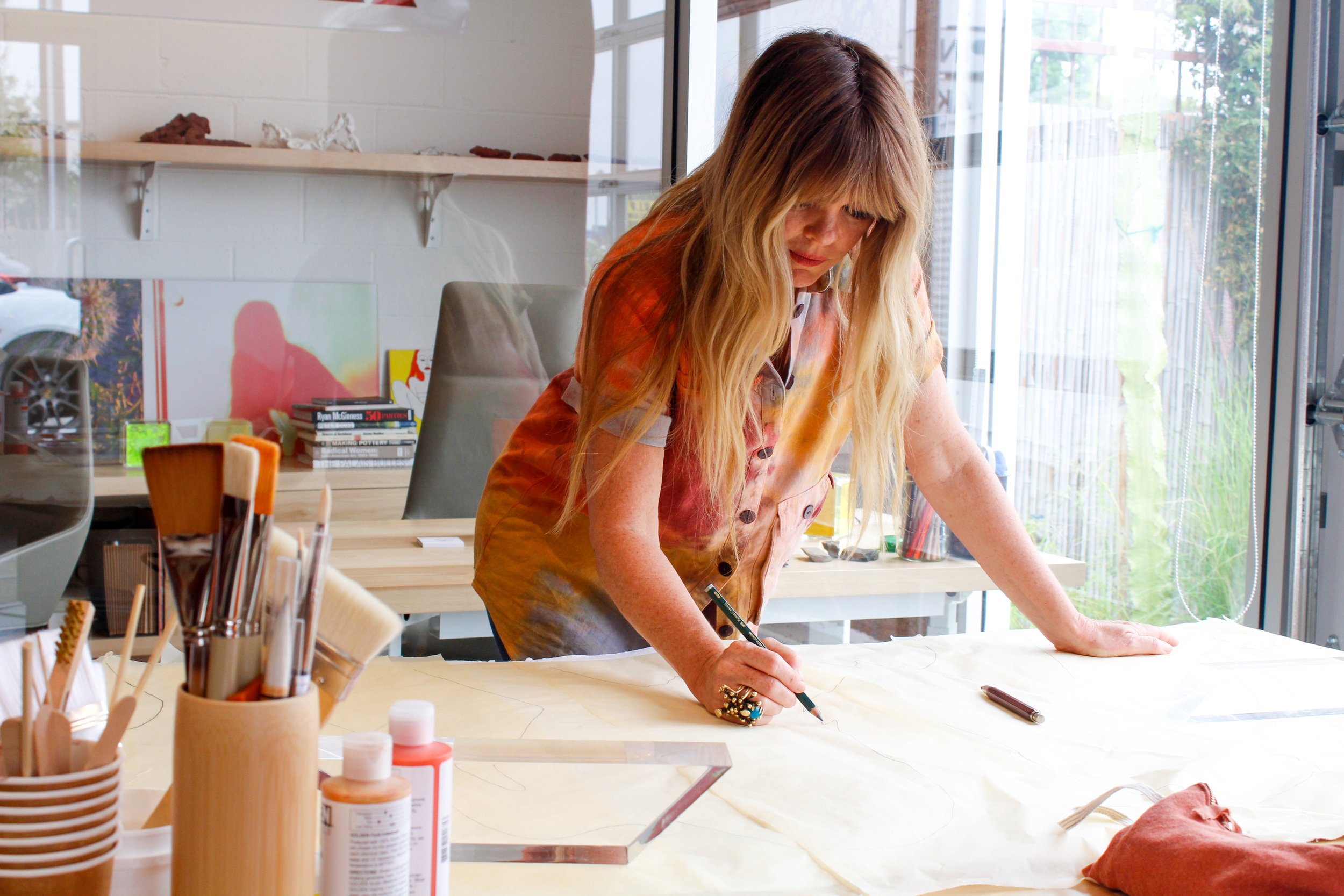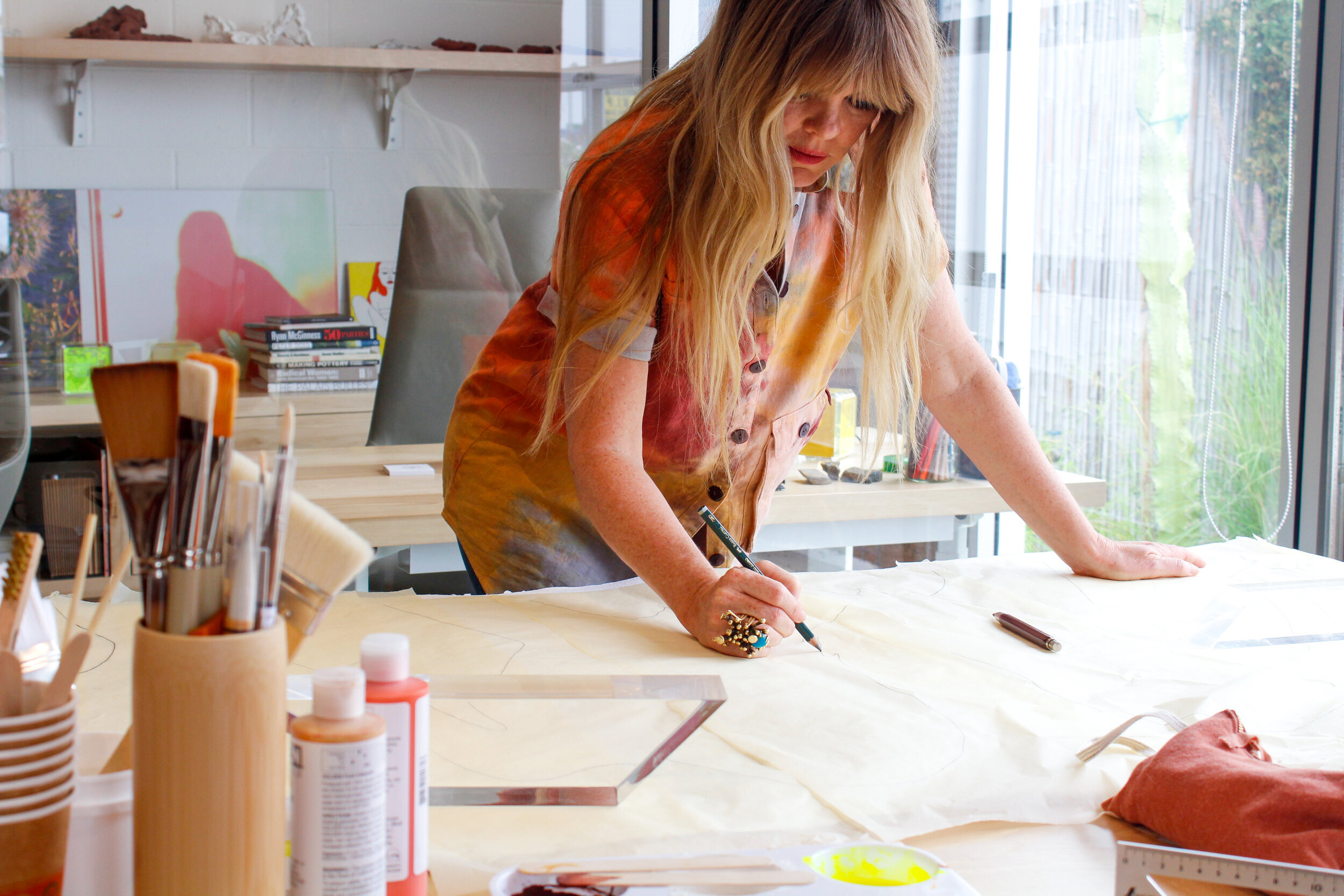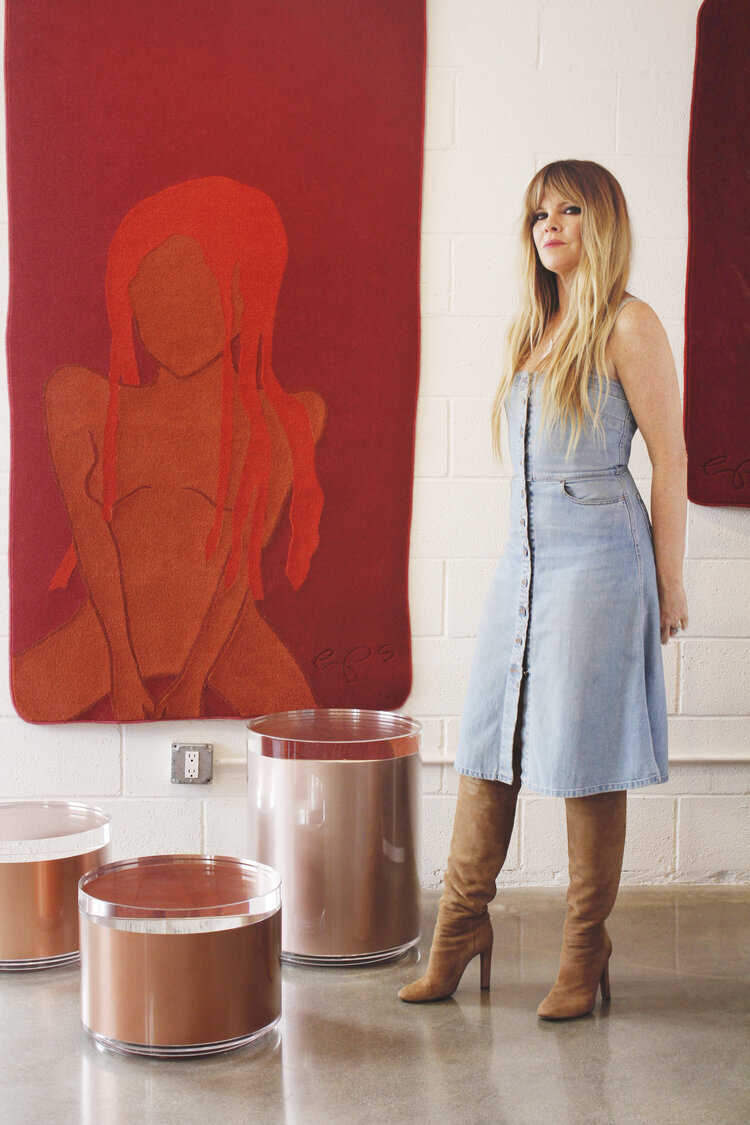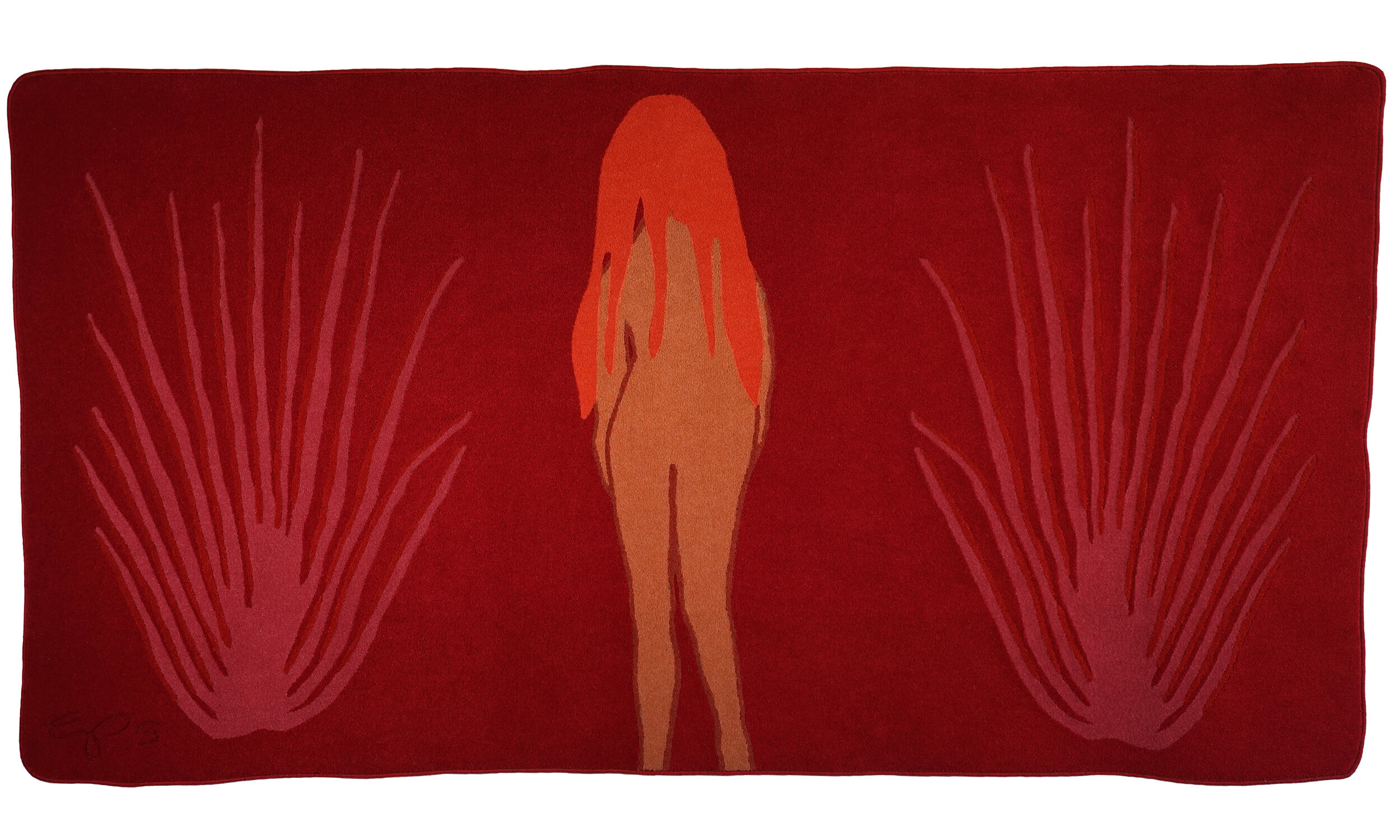FLAUNT
Meet the multidisciplinary artist making new waves in the art world while getting the attention of celebrity furniture collectors.
Written by Joshen Mantai
Artistic Shapeshifting in Equilibrium
While the collective isolation and ensuing mania from the reality of the past nine months has gotten to almost everyone’s mental health—artist Elizabeth Paige Smith is mostly unfazed. She has seized the chaos of quarantine as an opportunity to take a “deep dive into communications,” viewing social media as an advantageous tool for creative possibility. Smith is a renowned furniture designer and artist with a coveted studio on Lincoln Boulevard in Venice, collectors of her high-end tables and vortex commodes amongst the likes of celebrities Gwyneth Paltrow, Kanye West, Kirstin Dunst, and Patricia Arquette. Her unique sensitization to textures, the environment, light, and overall ability to break free from the pressurized conformity of contemporary art have earned her exhibition spots in the Smithsonian Cooper Hewitt National Design Museum, amongst many others. Smith was impressionably featured in the first “Made in California” exhibition at LACMA, along with Sam Maloff and Frank Gehry. FLAUNT had the opportunity to sit down with Smith over Zoom to discuss her search for creative opportunity amidst quarantine, artistic values, and future projects.
Prior to the origins of the pandemic, Smith relays that she had detailed plans for studio visits that collapsed, which she exclaims set her “spiraling back into the emotional headscape I was in before living in isolation.” Smith had an atypical and unparalleled experience that inadvertently prepared her for the pandemic — living for ten years in isolation at the Frank Lloyd Wright Foundation house in Woodside, just outside of tech-buzzing metropolis Palo Alto. During her time away, Smith found inspiration in the midst of her rekindled connection with nature, creating a series of eight stone sculptures titled “Naked and Fucking Free.” “I’ve always found nature as a source of inspiration,” she explains. “I’ve always contrasted my own feelings and thoughts with nature, and the consistency of nature.” Her inspiration for the eight figurines stemmed from her steady fascination with organic matter and geometric figures, crafting sculptures that portray female figures in their sense of emotional independence, but accompanying vulnerability. Smith describes them as representing an “emboldened feminine state,” describing how she purposefully utilized denotatively masculine materials like stone to contrast the conventional thinking of what it means to be feminine.
Smith’s work can easily be described as feminist—a facet she says she was surprised to realize until her friend pointedly referred to her work as such. She stands behind the assumption, being influenced by a long lineage of strong women in her family who worked within various artistic mediums. She claimed the artistic space of design with utter reverence, soon discovering neither design nor art was an easy territory to traipse into. Despite being fortunate enough to capture the rapid attention of acclaimed publications like the New York Times and being invited to exhibit in Milan and Japan with elite design groups, she noticed the male-dominated nature of the industry. “At the time design was male-dominated, run by a group of guys in New York, and no women in America were participating in global exhibitions,” she remarks. “I felt very isolated and unsupported, aside from a few key people.”
However, this did not stop Smith’s ambitions, as she elucidates that not giving up is “a part of the creative war.” Smith continued to shift gears, looking for opportunity wherever she could find it, redefining artistic expression in her examination of raw emotion in her art. This rawness is on display in her series of woven warm-colored tapestries, named “A Very Long Day,” which takes an intimate glimpse into the sensory overload of challenges faced in cherished relationships. “There’s a lot of gravity in that experience,” she shares. “There can be a lot of inner turmoil, and there’s a spectrum we experience, which I focused on a lot in this work.”
Smith’s potent ability to delineate emotionality within physical raw material is an aspect that originated from her inclinations as a child, making creations with mud in the Cayman Islands, where she grew up. Here, Smith expresses that she sought isolation as a form of comfort, spending most of her time underwater, hyper-aware of details, equilibrium, and weightlessness within her domain. “I feel invincible with equilibrium,” she reflects. “All of your senses are nurtured underwater, so it heightens your awareness. Feeling invincible is having your own forcefield. There was a time when challenges around me were out of my control. I was taxed by others’ chaos, and I developed this concept around my forcefield, where I could create my own equilibrium.”
In her exile of the outside world, Smith says she has developed the “chance to pay attention subtly,” something she encourages of other artists around her. In terms of her future pursuits, Smith sees herself “opening up to a more conceptual realm,” already starting to traverse the juxtaposition of human voice and natural sound in her collection of sound poems titled “Waiting For You,” set in a pristine California poppy field. While what work we see from Smith next may be a surprise, it’s clear her multidisciplinary accolades are only beginning, apparent in her unwavering confidence within the exploration of different media, adaptable to any challenge that dares to come her way.
Find the full article here
See more of Naked + Fucking Free | A Very Long Day
Stay Connected
FORBES
A California Artist Finds Peace In Isolation
FORBES
August 2020
Written by Brienne Walsh
A California Artist Finds Peace In Isolation
A few weeks ago, I had a lovely Zoom call with the artist Elizabeth Paige Smith, who goes by Betsy. Towards the end, she told me that earlier that day, she had stuck her head in a water tower on her six-acre property in Woodside, California, and listened to the sound of her own breath as a form of sound art. As a mother of two young children currently living in a constant state of anxiety, I wished that I could achieve that same zen in my own mosquito-filled backyard in Savannah, Georgia.
For the past ten years, Smith says, she has lived in isolation in a Frank Lloyd Wright Foundation house in Woodside, a wealthy community just outside of Palo Alto. The experience prepared her for the isolation many people have experienced during the COVID-19 pandemic. “I didn’t have any distractions,” she told me. “I was really one with the coyotes, with the hawks. I was in unison with the frogs.”
Before moving to her current home, Smith was a successful furniture designer and curator with an atelier on Abbott Kinney Boulevard. Celebrities including Gwyneth Paltrow, Kanye West, Kirstin Dunst and Patricia Arquette collected her work. The life she led in Venice, while glamorous, distracted her from accessing the sense of equilibrium with nature and her own creativity she had first discovered while a child in the Cayman Islands.
She found it again by chance on the estate where she still lives in the hills above Silicon Valley, which belonged to the man who would eventually become her husband. “I came and experienced such an incredible soul connection, both with him, and with the land itself,” she said. She decided to leave her life in Venice, and merge with her soul mate.
In her decade of isolation, Smith produced a number of bodies of work, among them “Naked and Fucking Free,” a series of anthropomorphic stone sculptures, and “A Very Long Day,” a series of tapestries in burnt sienna and orange that capture, she says, the raw and untamed spirit in every woman.
“Naked and Fucking Free” consists of eight stone sculptures that look like women basking, spread-eagled, or crouched, in the sun. They were inspired by a trip Smith took in 2013 to a stone quarry, where she found stones that looked like the legs of a female figure. Smith, who describes herself as “material curious,” said that she spent the next decade combing quarries in the Pacific Northwest for the perfect stones to complete each of the eight bodies.
“I recognize the material of the stones as being very masculine,” she told me. “I just sort of want to break free and challenge the preconceived ideas of feminine and masculine within the body.”
There is a freedom and wildness to the sculptures. They are also extremely redolent of the work of 20th century sculptors including Josef Pillhofer and Max Bill. It is easy to see Kanye West getting a glimpse of the series, and ordering an army of the spread-eagled women for his ranch in Cody, Wyoming. It’s also easy to see how the series could be inspired by Smith herself, removed enough from human contact that she can truly be in communion with her own personal Garden of Eden.
The woven strands of the tapestries in “A Very Long Day” read like a love story in a song by Joni Mitchell, or a story Joan Didion. A nude woman with very long orange hair appears in tableaus that are alternated with phrases like “feel the warmth,” or “I waited for you all day.” They look like something that someone who collects crystals would very much enjoy having in their sunny mid-century modern home. Smith says she hoped to capture the “guttural” energy all women know they possess, but don’t necessarily know how to channel.
Smith had recently decided to re-emerge from her estate in Woodside, and re-immerse herself in the Venice art scene, when the coronavirus pandemic struck. For now, she’s back in her aerie.
In terms of advice she would give to people experiencing isolation for the first time, she says: “I think the best thing is to find a connection to what really makes you happy. Create boundaries for technology and give yourself space to disengage.”




















